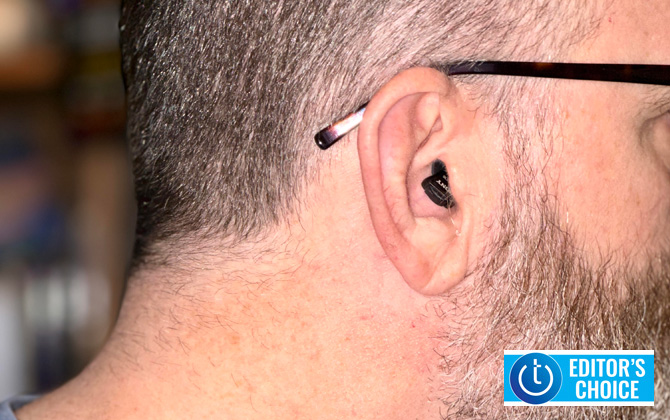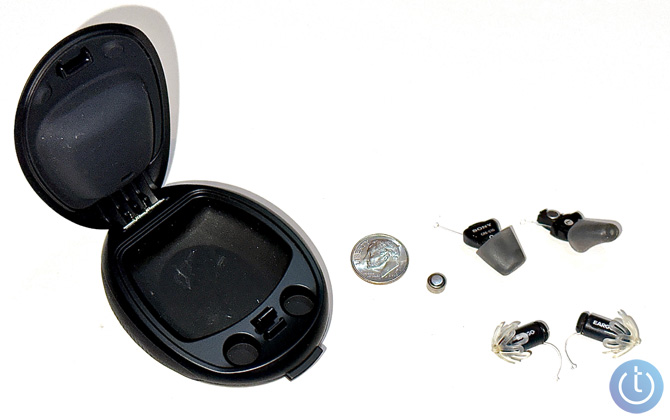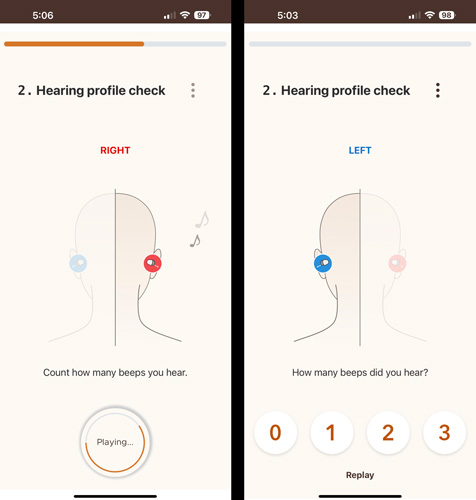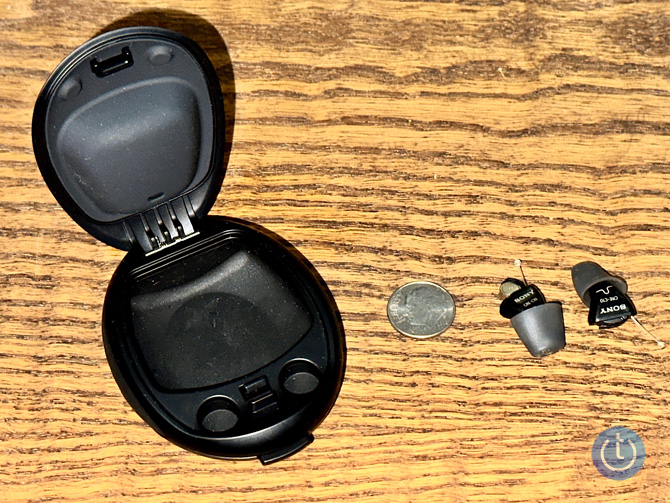We may earn commissions when you buy from links on our site. Why you can trust us.
Review: Sony CRE-10 OTC Hearing Aids Deliver Great Sound with One Flaw
Sony's first OTC hearing aid, the CRE-C10 ($999.99), should be and could have been the model by which all subsequent no-frills OTC hearing aids should aspire. After an initial hearing test to personalize their amplification, you simply stick 'em in your ear, your hearing volume essentially doubles, and then you forget you're even wearing them all day long. Simple and effective hearing assistance – just what the vast majority of the mild hearing-impaired population needs and wants without the doctor ordering it and charging you a fortune.

But while Sony giveth superb and discriminating audio amplification with great long-term wear comfort, they taketh away with the C10 being powered by minuscule single-use batteries, a major annoyance. I also have a bone to pick with Sony concerning the C10's price.
Rather than Bluetooth earbud-style buds with added hearing aid capabilities, the CRE-C10 are pure hearing aids comparable to the Eargo 5 and 6 prescriptive (i.e., the price includes tele visits with an audiologist) hearing aids and the OTC over-the-ear style Lexie B2 buds powered by Bose ($999). I've reviewed a plethora of hearing assistive devices over the last couple of decades and plan to review every new OTC hearing aid I can get my fingers on and into my ears.
Like the Eargos, the C10s are tiny, designed to be almost unseen in the ear, and don't include Bluetooth, so you don't get music listening or phone calls through them. At the other end of the OTC hearing aid design spectrum are the visibly obvious and fully Bluetooth functional buds, such as the Jabra Enhance Plus ($799) and the upcoming HP Hearing PRO powered by Nuheara ($699).
But instead of rechargeable batteries that nearly all Bluetooth earbuds and hearing aid batteries now operate on, the C10 are powered by round, nearly microscopic single-use size 10 hearing aid batteries that annoyingly require the sharp eyesight, finger dexterity, and rigid attention to detail of a watchmaker to swap them out. If you forget to tote extra batteries – and you will (and I did twice during my two-week-plus review period) – be ready to conduct a drug store battery treasure hunt. By comparison, the Eargo 5 and 6 and the Lexie B2 are both rechargeable, providing around 12-16 hours on a single charge.
While Sony may have set an aural performance standard with the CR10, it missed an opportunity to set a pricing standard. Not only are the C10 a thousand bucks, but you also have the additional ongoing cost for the replacement batteries.
Let's put Sony's price in context. For someone facing a $4,000-$8,000 outlay for a similarly featured prescription hearing aid, or even the $2,450 for an Eargo 5 or 6, $1,000 for a comparable if not superior replacement such as the CRE-C10 and the Lexie/Bose B2 sounds like a real deal.
But the actual cost of making these buds, which don't include a rechargeable battery or Bluetooth, is minimal; hearing aid technology, for instance, is a mature, well-understood technology. High hearing aid pricing is primarily predicated on the ability of audiologists to charge a premium for them since they controlled a monopoly on the hearing aid product and their medical services – not on the actual hearing aid cost of goods. Sony could have charged $499 or even $799 (still high considering the tech involved), which would have severely undercut its current and upcoming competition and made them a hero in the hearing-impaired world.
Also, bear in mind that these current OTC hearing aid prices will likely seem high a year from now or sooner. There's no doubt that a lot more models will come to market next year, and the competition is sure to force prices to drop.
Set-up and ergonomics
The C10s are tiny and light, nearly the same size and configuration as the Eargo 5 and 6 (shown below), weighing only 1 gram each (Eargo lists the 5 at "1.015 ± 0.05g"). Included are extra small, small, medium, and large vented silicone ear tips, vented to allow you to hear ambient sound, including your own voice, simultaneous with and nearly indistinguishable from the amplified sound. Since the C10s aren't designed to seal your ear canal, you pick a tip size based on comfort and how well the buds stick in your canals without shaking loose through normal head movements throughout your day. Mine comfortably stayed firmly inserted with no trouble using all three sizes.

For setting up, Sony first instructs you to turn off your phone's Bluetooth before "pairing" the C10s. Many post-purchase complaint reports about the C10 revolve around an inability to pair them, which I suspect is because buyers were trying to Bluetooth pair them without first reading the instructions. But the C10 don't use Bluetooth. Instead, the C10 connect to your smartphone and the limited Sony Hearing Control app "via a wireless high-frequency acoustic link," according to Sony.
Once you've "paired" the C10 to your smartphone and you've picked your tips, you'll take an app-guided hearing test to separately personalize the left and right bud amplification to compensate for your specific hearing loss in each ear. All OTC hearing aid hearing tests I've encountered, including those of the Jabra Enhance Plus and the Eargos (the audiologist Eargo includes doesn't conduct the hearing test), are essentially the same: in a quiet room, you insert a single bud, then listen while a series of varying tones at different frequencies and volume levels are played, and you simply tap the screen when you hear each; the process is then repeated with the other bud.

Once the C10 are personalized, you're pretty much done. The minimal Sony Hearing Control app includes only slide microphone volume between 0-15 and to increase/decrease bass and treble emphasis, but I could detect no difference in manipulating either, and there are no ambient or situational presets. Quite frankly, I didn't care that the app did nothing since the whole idea of the C10 is to not worry about them once they're in your ears.
Audio performance
Sony knows sound, so it's not a surprise that the C10s create completely natural amplified sound. While not producing the impressive volume of the Jabra Enhance Plus, the C10s nearly doubled my natural hearing with noticeably more volume than the Eargo 5 without a sacrifice in quality – both the Sony and the Eargo produce natural sounds without added artifacts, echo, or artifice. And, unlike the Jabra Enhance Plus that seal off your ear canal, you can naturally hear your own voice.
You get not only high volume but excellent voice-specific amplification with the C10. At large holiday dinners and at group dinners at noisy restaurants, I was often the only one not asking, "what'd you say?" While I was often asked to repeat myself – and no one has ever accused me of speaking softly – all I needed to hear C10-enhanced conversation from across the table was to occasionally cup my ear.
The C10 not only effectively enhances voice, but they seem to be more discriminating than other hearing aids or sound amplifiers I've used, including the Eargo, that seem to boost all noise equally. Ambient noises such as walking on even slightly creaky floors, flipping light switches, running water, keyboard key clacking, etc., didn't seem as sharply amplified as with other hearing assistive devices I've used. In addition, Sony suppresses nearly all wind noise until gusts reached 13 MPH or so, which is a bit more effective than the Eargo 5, but even then, the wind noise wasn't the steady shriek other hearing amplifiers often produce. However, the C10 can suddenly and startlingly squeal when they “hear” higher-pitched sounds, especially from the TV.
Comfort-wise, I barely sensed the C10 even up to wearing them 18 hours at a stretch and often forgot I was even wearing them. While not as nearly invisible as the Eargo models, the C10 are largely impossible for anyone standing right in front of you to see.
To listen to music, you can easily and comfortably slip on a pair of cup-style headphones with the CR10s in your ears. Phone call volume, with the phone pressed to your ear or using the phone's speaker, is similarly naturally boosted.
The battery problem
Sony says you'll get 70 hours of power via the size 10 single-use batteries, which comes out to around five days. But you can't turn the C10s off, and they don't automatically switch off when you take them out of your ears. To optimize battery life, you need to carefully open the tiny battery doors to disconnect power when you store the C10s in their slim oval case. Yes, rechargeable Bluetooth hearing aid batteries last just 5-16 hours, but we've grown used to both occasional and overnight recharging of wearable gadgets, and their apps reported when they need to be charged.
You'll hear a short sequence of tinkle tones when the C10 battery life is winding down, but with no indication of how much power remains; I found Murphy's Law reigned – the batteries seem to die just when I was in the worst circumstances to change them.
Sony helpfully includes a six-pack of size 10 hearing aid batteries to get you started. In the real world, size 10 hearing aid batteries cost 20 to 40 cents each, depending on where you buy them and in what quantities. You also need to be careful of stores stocking old cells – a CVS at which I bought some extras only stocked size 10 batteries that were recommended to be used by March 2020.
Each of these tiny round batteries is roughly the size of a thick pin head, so expect to drop and/or lose one or more batteries when you change them – these suckers will roll on forever, usually under immovable furniture. You'll want to change them on a tabletop with plenty of light.

The carry case cover has a rubberized cushion inside, so when you close the case with the C10 battery slots open, the buds won't rattle around, and the batteries will stay put.
You'll be able to buy replacement tips for the C10s – $14.99 for a six-pack, but just clearing them of wax periodically should help avoid this expense. Eargo recommends you buy expensive new ear petal tips, but with judicious cleaning, I haven't had to in the year-plus I've been wearing them.
The bottom line

Don't get me wrong – I really appreciate how effectively, effortlessly, and efficiently the Sony CRE-C10 enhanced my hearing. But no matter how much I admire their discriminating and natural sound amplification and in-ear comfort, having to remember to buy and carry around extra batteries, needing to open up the tiny battery slot before stowing them when not in use to preserve battery power, and having to awkwardly swap out the batteries usually at unpredictable and inappropriate times and circumstances every few days nearly negated all of the C10's aural advantages in my early days of testing.
But, over the testing period, I've started to get into a battery carry and swap routine. Sure, each time I have to change the batteries I curse the C10s, but they just sound and feel so good.
If the Sony CRE-C10 are of interest to you but their $1,000 price is still too steep, I advise patience – at least wait until I've had a chance to test the bud-style Bluetooth Sony CRE-E10 ($1,299), the Lexie B2 ($999), and the HP Hearing PRO ($699), all rechargeable models. At some point, perhaps even in the next few months, competition will force Sony to cut the C10's price, or a similar no-frills OTC hearing aid just as or nearly as good but with rechargeable batteries will come along from another vendor at a significantly lower price point.
[Image credit: Stewart Wolpin/Techlicious]
Stewart Wolpin has been writing about consumer electronics for more than 35 years, including news, reviews, analysis and history, and has attended and covered nearly 50 Consumer Electronic Shows and around a dozen IFA shows in Berlin. For the Consumer Technology Association (CTA), he is an elector for and writes the official biographies of the annual CT Hall of Fame inductees, and is the keeper of the industry’s official history.
Discussion 
As a first-time buyer with slight hearing loss (per audiologist), I look forward to your review of Sony OTC CRE-E10, rechargeable.Sony specs say it has a 26-hour run-time. It appears size is significantly larger than CRE-C10. For an “inside ear canal” hearing aid, This appears to have all features I would like. (not certain, however, if it has different program settings for various sound/noise conditions like crowds, restaurants, etc…
in concert with others, I eagerly await your CRE-E10 review.
thanks for your spot-on review; a new world of hearing aids is finally beginning.
Andy Bartlett
I have the Sony CRE-10 hearing aids, and I chose them specifically because the DON’T have rechargeable batteries. $1K is expensive enough that I want them to last a very long time, and rechargeable batteries degrade over time. They can be expensive to replace, too. In many cases, when the rechargeable battery is dying, the device is out of warranty and they have to be replaced out of pocket. By replacing the battery every few days, I think I’ll be able to get more years out of one device.
Thanks for an excellent, detailed and balanced review. I’ve been looking for an OTC as backup for my pricey Signia HAs, which are “cheap” in the audiology world at under 2 grand apiece. Also enjoyed your article about the new Sony, but agree that the price is too high.
I thought it would be invisible at least from the side , unless you look through the ear canal. For everyone will seat like that ? Thanks
What you see in the photos is the normal fit. They’re far enough into the canal so they’re largely invisible from the front, but they are visible from the sides.
Thank you for a comprehensive review of the Sony Cre-C10 as well as your review of the Lexie B1. I have worn aids for 14 years, have worn 2 prescription brands, and am about to buy new pair. Your reviews are not only inclusive, they pull no punches, and have helped me form a firm opinion of which brand I will buy.
Keep in mind hearing aids with rechargable batteries are disposable. The non replaceable batteries usually lasting 3 to 5 years with their charge ability draining over time. After that the aids need to be replaced. The size 10 replaceable batteries to me are an advantage, not a problem. Compaire the cost of the batteries to needing to replace your aids every few years.
Hi Brian,
I talked this through with Stewart and he points out that rechargeable batteries only lose around 5% of their power capacity over the course of a year, depending on make, model, and usage. So rechargeable hearing aids with an initial 16-hour life will still supply 14 hours 2-3 years from now. And even after 4-5 years, rechargeable hearing aids might simply need to be recharged during the day for a short time to supply power for the rest of the day. Given this, hearing aids with rechargeable batteries wouldn’t need be replaced for years just because of potential battery life loss.
For the new Sony CRE-C20, which Stewart just reviewed, Battery life loss over time is less of an issue because you’re starting with a whopping 28 hours on a single charge. Even with a 5% per year loss in power, Stewart estimates you might still get 16 hours of life a decade from now.
Best,
Josh
















From Thomas on December 14, 2022 :: 11:18 pm
Looking forward to your review of the Sony CREE10. When do you expect to post?
Reply